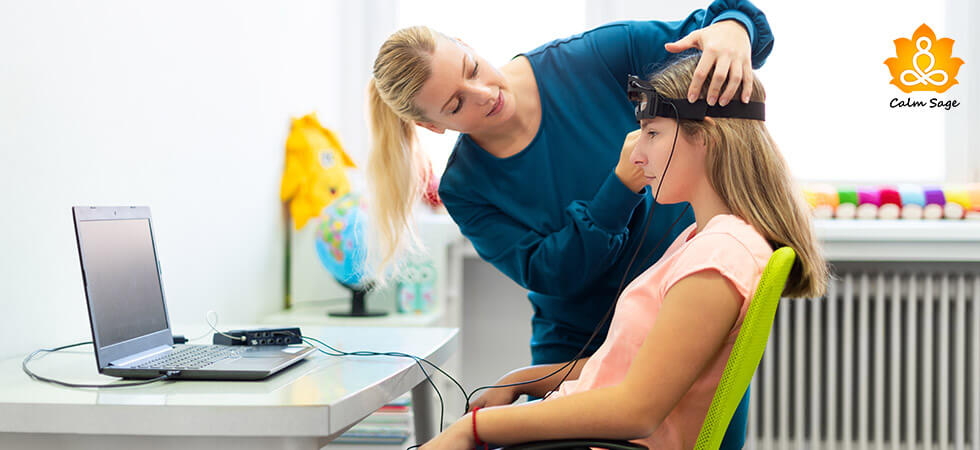All You Need To Know About Neurotherapy For Mental Health Disorders

Neurotherapy is one of the effective treatment methods for treating neurological, brain-related, and psychiatric disorders. Neurotherapy is still evolving but still it is known to be an efficient therapy treatment option for treating neurological and mental health disorders as it alters brain functioning. In this blog, let us read what Neurotherapy is, its benefits, possible research and applications supporting its efficacy, and more.
Let’s get started!
What is Neurotherapy?
Neurotherapy is a newly evolved drug-free treatment that iproves brain functioning with the help of newly introduced technology. Neurotherapy uses brain plasticity to create new connections and reorganize neural pathways which eventually improve the overall functioning of the brain.
This therapy is known to be effective for the treatment of various neurological and psychological conditions. Generally, there are two types of Neurotherapy, the first one is Neurofeedback and the second one is Neurostimulation. In Neurofeedback, patients learn how to control brain functioning with the help of real-time brain activity displays, this can also be referred to as brain training.
During Neurostimulation, neural activities are modified through electromagnetic pulses through the scalp. Both Neurotherapy types are popular for treating attention-deficit hyperactivity disorder (ADHD). However, research shows that this therapy can also be effective for treating various neurological and psychological disorders such as obsessive-compulsive disorder, anxiety, depression, brain injury, and migraine.
How Does Neurotherapy Works?
Neurotherapy helps in rewiring the neurons which improves the functioning of the brain. Common applications for Neurotherapy are:
- Cognitive learning
- Habit or addiction management
- Mood disorder management
- Neuron healing
- Neuromodulation
- Neurostimulation
- Performance improvement
Different modes of Neurotherapy are used for the rewiring of the brain. All of these modes are administered through positive reinforcement. During sessions, when the client’s brain starts producing optimal activity, positive reinforcement begins. This is how the client’s brain is rewired towards normal brain activity through Neurotherapy.
Neurotherapy is a promising therapy for patients who are not able to overcome their illness through standard procedures of treatment. Neurofeedback is still in its initial stage, still, Neurotherapy is well-known for treating learning disabilities such as dyscalculia and dyslexia (shown in small studies).
Uses of Neurotherapy
The Brain is a complex part of the human body and each system installed in our brain needs a balance of chemical and electrical activity to maintain stability. Mostly, Neurotherapy helps in correcting dysregulated neural activities such as attention dysregulation, behavior dysregulation, emotional dysregulation, motor system, and nervous system dysregulation.
Below listed are some of the common neurological and psychiatric conditions that can be treated with Neurotherapy:
- Anxiety disorders
- Autism spectrum disorders (ASD)
- Attention deficit hyperactivity disorder (ADHD)
- Brain stroke or injury
- Bipolar disorder
- Cluster headaches
- Depression
- Emotional regulation
- Migraine
- Learning disorders
- Neuropathic pain
- Obsessive-compulsive disorder (OCD)
- Schizophrenia
- Post-traumatic stress disorder (PTSD)
- Substance use disorders
Benefits of Neurotherapy
Below listed are some of the well-known benefits of Neurotherapy:
- Enhances focus and memory
- Enhances athletic performance
- Provides long-lasting effects
- Provides mental clarity
- Promotes minimal side effects
- Promotes healthy sleep
- Provides non-invasive therapy sessions
- Reduces therapy timings and needs for medications
Neurofeedback and Treatment
Neurofeedback helps in addressing irregular brain waves caused by dysfunctional neural patterns. Generally, maladaptive neural patterns affect thoughts, emotions and behaviors that cause distress.
Herein, Neurofeedback helps in empowering clients by making them learn self-regulation of brain activities through audio or visual feedback displayed on the screen. New advancements in technology have made Neurofeedback a portable and individualized therapy program for people around the globe.
Neurofeedback has evolved over time and there are different types of Neurofeedback therapies that can be applied according to the symptoms or conditions such as
- Frequency Neurofeedback: ADHD, Insomnia, and Anxiety
- Slow cortical potential Neurofeedback (SCP-NF): ADHD, Migraines, and Epilepsy
- Live Z-score Neurofeedback: Insomnia
- Low-resolution electromagnetic tomography (LORETA): Depression, addiction, and obsessive-compulsive disorder
- Hemoencephalography Neurofeedback: Migraine
- Functional magnetic resonance imaging: ADHD, anxiety, depression, substance use disorder, schizophrenia, and PTSD.
Neurostimulation and Treatment
Neurostimulation is a well-known and accepted type of Neurotherapy as it helps in self-regulating brain activity. Neurostimulation is a passive approach as it changes brain activity through magnetic and electric brain stimulation.
During therapy sessions, low-voltage electromagnetic or electric current is administered. New advancements in technology have made Neurostimulation a portable and individualized therapy program for people around the globe.
Neurostimulation has evolved over time and there are different types of Neurostimulation therapies that can be applied according to the symptoms or conditions such as:
- Low-energy Neurofeedback system: ADHD, traumatic brain injury, insomnia, restless leg syndrome, fibromyalgia, depression, anger, and anxiety
- Transcranial electric stimulation: Depression, neuropathic pain, speech therapy for aphasic people, and negative symptoms of schizophrenia
- Transcranial magnetic stimulation: Treatment-resistant depression, OCD, depression, and migraine
- Deep brain stimulation: Tourette’s syndrome, OCD, Parkinson’s disease, and depression
Research and Current Development around the Efficacy of Neurotherapy
I could find a number of studies supporting the efficacy and results of Neurotherapy. Some of the studies yielded confusing results. Therefore, I have compiled a list of studies for better clarification:
Study 1: Neurofeedback as a treatment intervention in ADHD: This study shows how Neurotherapy promotes a state of relaxation and attention as compared to ADHD medications.
Study 2: Neurofeedback: A comprehensive review of system design, methodology, and clinical applications: This study reveals how Neurotherapy can be effectively used for increased attention and reducing hyperactivity behavior as compared to ADHD medications. This study also talks about positive results for people struggling with addictions such as alcohol, cocaine, mobile phones, or computer games. This study also reveals how Neurotherapy can be used to reduce unhealthy food cravings.
Study 3: Combined Neurofeedback and heart rate variability training for individuals with symptoms of anxiety and depression: This study shows how 30 sessions of Neurotherapy can improve heart rate variability for people with severe anxiety and depression. This study also mentioned normal brain activity noted during sessions.
Study 4: A randomized controlled study of Neurofeedback for chronic PTSD: This study shows how 24 sessions of Neurotherapy significantly helped in reducing symptoms of chronic PTSD.
How to Get Started?
After reading and compiling all the studies and research around Neurotherapy, we could conclude that Neurotherapy comes with various benefits and it can be effectively used as an alternative to traditional therapy approaches such as cognitive behavioral therapy (CBT). However, Neurotherapy can be a time-consuming and expensive therapy type that may need booster sessions as well.
If you are looking forward to Neurotherapy sessions for yourself or your loved ones, firstly please check with your local health professionals and insurance providers. You can also take the help of an online neurotherapist directory based on your location and choice of specialty.
Frequently Asked Questions
- Where is Neurotherapy typically used?
Neurotherapy is generally practiced by psychotherapists, psychologists, therapists, and physicians in a clinical office setting wherein different exercises and techniques are used.
- How Neurotherapy can help improve brain function?
Neurotherapy is known to be an effective therapy treatment for neurological and mental health disorders. As it does not involve the use of medications, the side effects get reduced and the brain activity is improved.
- What specific functions of the brain can Neurotherapy target?
Mental health disorders impact brain activity differently, with the help of Neurotherapy, Neurofeedback, and brain mapping, the brain’s activity is noted and altered towards a healthier pattern.
- What are the techniques of Neurotherapy?
There are two types of Neurotherapy, Neurofeedback and Neurostimulation. Neurofeedback uses the brain’s activity for teaching control and regulation. Neurostimulation uses electrical or magnetic impulses to alter brainwaves.
I hope this blog helps you understand everything you want to know about Neurotherapy. For more such content, connect with us through all social media platforms.
Thanks for reading!




















